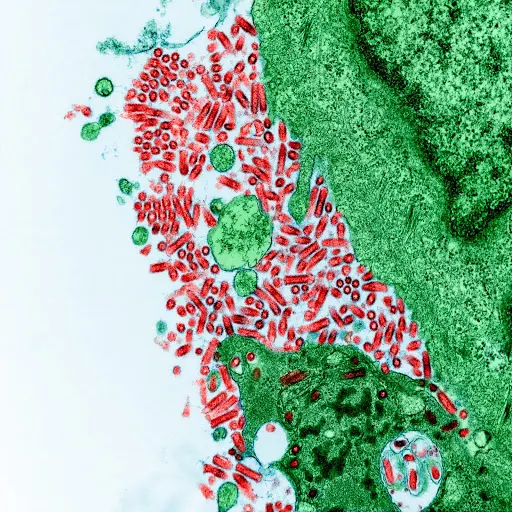Rabies Vaccine, as the name suggests, is a vaccination used to prevent and control rabies disease in humans and animals. Rabies occurs everywhere and kills at least 55,000 people per year. The Rabies Virus was not seen through a microscope until 1950s.
Rabies Vaccine.
🌕 Rabies-The Disease:
⚽ Rabies is an infectious disease caused by rabies virus. The rabies virus is a RNA virus which affects the brain and spinal cord, in short the central nervous system, of humans as well as of animals. The virus travels from nerve cells to the brain, it multiplies in number and causes destruction of brain cells which causes death. The infection might become deadly if not treated well before the symptoms appear.
🌕 Structure of the Rabies Virus:
⚽ The Rabies Virus generally attack animals like: dogs, bats, skunks, foxes, monkey, raccoons, etc. It is through these animals that the diseases gets spread in human beings.
Rabies Virus in Human Cells.
Structure of Rabies Virus.
⚽ As it is a communicable disease, the rabies virus spread through animal's saliva or brain tissues. Mostly, it gets transmitted to human beings through dog bite. Rabies virus attacks the nervous system and the person starts having: fever and fatigue hallucinations, agitation, seizures, then finally coma and death. In animals, the symptoms usually are irritation, agitation and aggressive behaviour.
Symptoms of Rabies Virus affection in human beings.
🌕 Louis Pasteur and Émile Roux:
⚽ Prior to the discovery of the rabies vaccine, every rabid-case would result in death. In 1888, two French Scientists, Louis Pasteur and Emile Roux developed the first rabies vaccine.
Right side - Louis Pasteur ; Left side - Émile Roux.
⚽ Pasteur, unlike his many colleagues, did not follow the theory that “ disease come from nowhere ”. His main focus of work was to determine the causes behind various diseases.
🌕 The Cure of Rabies:
⚽ The rabies vaccine was made up of a sample of virus cultivated from infected and death rabbit. The sample was weakened by allowing it to dry for a few days.
Pasteur did the experiment in dogs.
⚽ Pasteur observed that while transmitting rabies virus from one rabbit to another, the healthy rabbit did not become as sick as the first one. This meant that the rabies virus was weakening and injecting the healthy rabbit with the weak virus which which gave immunity to the healthy rabbit.
Louis Pasteur used two rabbits for his Rabies vaccine Reasearch.
⚽ The rabies vaccine was first used on a nine-year-old Joseph Meister on July 6, 1885, who had been bitten by a rabid dog. He was the first human being to be vaccinated by rabies vaccine.
Joseph Meister.
" I Only Wish I'd Invented The Rabies Vaccine Before My Dog, Old Yeller, Got Sick."
— Louis Pasteur.

















































